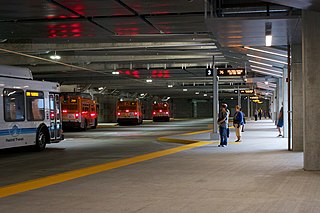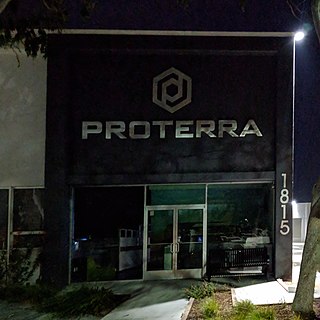North American Bus Industries, Inc. (NABI) is a former manufacturer of heavy-duty transit buses with its headquarters, bus manufacturing and assembly operations, located in Anniston, Alabama. Its products ranged from 31-feet to 60-feet in length, and were sold to operators throughout the United States and Puerto Rico. NABI's U.S. operations also include an aftermarket parts division in Delaware, Ohio, and an after-sales service center at Mira Loma, California.

The Los Angeles County Metropolitan Transportation Authority (LACMTA), branded as Metro, is the county agency that plans, operates, and coordinates funding for most of the public transportation system in Los Angeles County, California, the most populated county in the United States. The agency directly operates a large transit system that includes bus, light rail, heavy rail (subway), and bus rapid transit services; and provides funding for transit it does not operate, including Metrolink commuter rail, municipal bus operators and paratransit services. Metro also provides funding and directs planning for railroad and highway projects within Los Angeles County. In 2022, the system had a total ridership of 255,250,500 and had a ridership of 812,300 per weekday as of the first quarter of 2023. It is the single largest transit agency within the county as well.

The Neoplan Transliner was a series of related public transport single-decker bus models introduced by Neoplan USA in 1981 and produced until the company declared bankruptcy in 2006. It was available in various lengths ranging from 26 ft (8 m) to 60 ft (18 m) articulated, and was marketed against the Rapid Transit Series, Flxible Metro, Gillig Phantom, New Flyer High Floor, and Orion I.

The G Line is a bus rapid transit line in Los Angeles, California, operated by the Los Angeles County Metropolitan Transportation Authority (Metro). It operates between Chatsworth and North Hollywood stations in the San Fernando Valley. The 18-mile (29 km) G Line uses a dedicated, exclusive right-of-way for the entirety of its route with 17 stations located at approximately one-mile (1.6 km) intervals; fares are paid via TAP cards at vending machines on station platforms before boarding to improve performance. It is one of the two lines in the Los Angeles Metro Busway system.
Neoplan USA was a major transit bus manufacturing company based in Denver, Colorado. It started as a subsidiary of the German corporation Neoplan in 1981 with its main factory and headquarters in Lamar, Colorado. In 1998, Neoplan USA was acquired by Willis Stein & Partners and became an independent licensee of designs from the German company Neoplan. The company declared bankruptcy in 2006.

The Orion V was a line of rigid high-floor transit buses available in 32', 35', and 40' lengths manufactured by Ontario Bus Industries between 1989 and 2009. The conventionally powered buses, either with longitudinally mounted diesel or natural gas engines, used a T-drive transmission coupling. The Orion V replaced the Orion I, and was in turn replaced by the low-floor Orion VI and Orion VII.

The Orion VI was a low-floor transit bus available in 40' lengths manufactured by Ontario Bus Industries between 1995 and 2003. The Orion VI was intended to provide an alternative to the existing high-floor Orion V; both the V and VI were replaced by the partially low-floor Orion VII.

The Los Angeles County Metropolitan Transportation Authority operates a vast fleet of buses for its Metro Bus and Metro Busway services. As of September 2019, Metro has the third largest bus fleet in North America with 2,320 buses.

The Orion VII is a line of low-floor transit buses available in 30' rigid, 35' rigid, and 40' rigid lengths manufactured by Daimler Buses North America's subsidiary Orion Bus Industries between 2001 and 2013 in three generations. The conventional powered buses, either with longitudinally-mounted diesel or natural gas engines, used a T-drive transmission coupling. A series hybrid variant powered by a diesel-driven generator was also available. The Orion VII replaced the fully low-floor Orion VI and high-floor Orion V buses, and was manufactured until its parent company DaimlerChrysler withdrew from the transit bus market in 2013.

The J Line is a 38-mile (61.2 km) bus rapid transit route that runs between El Monte, Downtown Los Angeles and the Harbor Gateway, with some trips continuing to San Pedro. It is one of the two lines in the Metro Busway system operated by the Los Angeles County Metropolitan Transportation Authority (Metro).

Transfort is the public transportation operator for Fort Collins, Colorado. The system offers 22 regular routes, with 20 of them providing all-day service Monday through Friday. Six-day intercity service is provided by the FLEX to Loveland, Berthoud, and Longmont. Additionally, five routes for transporting Colorado State University students, faculty and staff run throughout the school year. In 2022, the system provided transportation services to 1,753,800 people.

Proterra is an American automotive and energy storage company based in Burlingame, California. The company designs and manufactures battery electric transit buses, battery systems for other heavy-duty vehicle builders, and charging systems for fleets of heavy-duty vehicles. Founded in 2004, it became a public company in June 2021. The company delivered 208 new transit buses and battery systems for 273 vehicles in 2021.
This article discusses the history of the Los Angeles County Metropolitan Transportation Authority, the regional transportation planning agency for Los Angeles County, California.

The New Flyer Low Floor is a line of low-floor transit buses that was manufactured by New Flyer Industries between 1991 and 2014. It was available in 30-foot rigid, 35-foot rigid, 40-foot rigid, and 60-foot articulated lengths. In addition to the different available lengths, the buses were sold with a variety of prime movers, ranging from conventional diesel and CNG combustion engines to diesel-electric hybrid, gasoline hybrid, and hydrogen fuel cell. The New Flyer Low Floor was restyled in 2005, resulting in two distinct variants: the Low Floor Restyled (LFR), which largely replaced the conventional Low Floor for transit service, and the Low Floor Advanced (LFA), which was intended for bus rapid transit service. New Flyer introduced the Invero in 1999 with the intent that it would replace the Low Floor line, but few were sold; in 2008, New Flyer introduced the Xcelsior, and the Low Floor line was discontinued by 2014.

The New Flyer High Floor was a line of conventional (high-floor) transit buses available in 35' rigid, 40' rigid, and 60' articulated lengths manufactured by New Flyer Industries between 1987 and 1996. The buses were powered by conventional diesel or natural gas engines using either V-drive or T-drive transmission couplings, with the exception of an articulated electric trolleybus variant manufactured for a single customer, the San Francisco Municipal Railway. The New Flyer Low Floor, a low-floor bus with a similar external appearance, was introduced in 1991 and proved to be more popular than the High Floor, which was discontinued in 1996 in diesel form. CNG high-floor buses continued to be built until 1999, and the articulated version was manufactured until early 2006.

The NABI LFW is a line of low-floor transit buses available in 30' rigid, 35' rigid, 40' rigid, and 60' articulated lengths manufactured by North American Bus Industries (NABI) between 1997 and 2015. In addition to the different available lengths, the buses were sold with a variety of powertrains, including conventional diesel, LNG, and CNG combustion engines along with a diesel-electric hybrid system

The NABI SFW was a line of standard (high)-floor transit buses available in 40' rigid and 60' articulated nominal lengths, manufactured by the Ikarus USA joint venture, then by American Ikarus and North American Bus Industries (NABI) between 1989 and 2013. In addition to the different lengths, the buses were sold with a variety of prime movers, including conventional diesel and CNG combustion engines and hybrid diesel-electric power.

The NABI BRT is a line of low-floor transit buses available in 60' articulated (60-BRT) and later 42' rigid (42-BRT) nominal lengths manufactured by North American Bus Industries (NABI) between 2004 and 2015. In addition to the different available lengths, the buses were sold with a variety of prime movers, ranging from conventional diesel and CNG combustion engines to diesel-electric hybrid.

The Proterra EcoRide BE35 is a 35 foot (11 m) fast-charge battery electric bus that seats 38 with a total passenger capacity of 60 in its composite low floor body. Foothill Transit was the first transit agency to operate the buses in revenue service, starting in September 2010. It is the first 30 ft (9 m) or larger, heavy-duty all-electric bus ever to complete federally required durability, reliability and safety testing at the Bus Research and Testing Center in Altoona, Pennsylvania. The 12yr/500,000 mi (800,000 km) STURAA test was completed on March 5, 2012.

The ENC Axess is a line of low-floor transit buses available in 35-foot and 40-foot nominal lengths manufactured by ENC in Riverside, California starting from 2003. In addition to the different available lengths, the buses are sold with a variety of prime movers, ranging from conventional diesel, LNG/CNG combustion engines, diesel-electric hybrid and hydrogen fuel cell with a traction motor.



















